A Deep Dive into HP's Knowledge Management Practices: A Case Study
VerifiedAdded on 2023/06/16
|7
|1889
|235
Case Study
AI Summary
This case study examines Hewlett-Packard's (HP) knowledge management initiatives, starting in 1995 with efforts like the Trainer’s Trading Post, HP library guidance, and the Product Processes Organization's (PPO) knowledge links. These initiatives significantly impacted HP's competitive advantages by leveraging market, customer, and product knowledge. The Trainer’s Training Post fostered a community among HP educators, while Connex aimed to expand network connections. Lotus Notes was used to establish knowledge bases like Training Library and Trainer’s Trading Post. However, Training Review, a collection of training evaluation reports, failed due to lack of participation. Bruce Karney introduced incentives like free Notes licenses and airline miles to boost knowledge base contributions, but faced challenges in sustaining fresh content. The knowledge management initiative with PPO customers was unsuccessful due to overly ambitious goals. Risks included potential information leaks and database losses, highlighting the importance of internet security. The case study provides insights into the strategies, impacts, and challenges of knowledge management at HP.

Running head: KNOWLEDGE MANAGEMENT
KNOWLEDGE MANAGEMENT
Name of the Student:
Name of the University:
Author note:
KNOWLEDGE MANAGEMENT
Name of the Student:
Name of the University:
Author note:
Paraphrase This Document
Need a fresh take? Get an instant paraphrase of this document with our AI Paraphraser
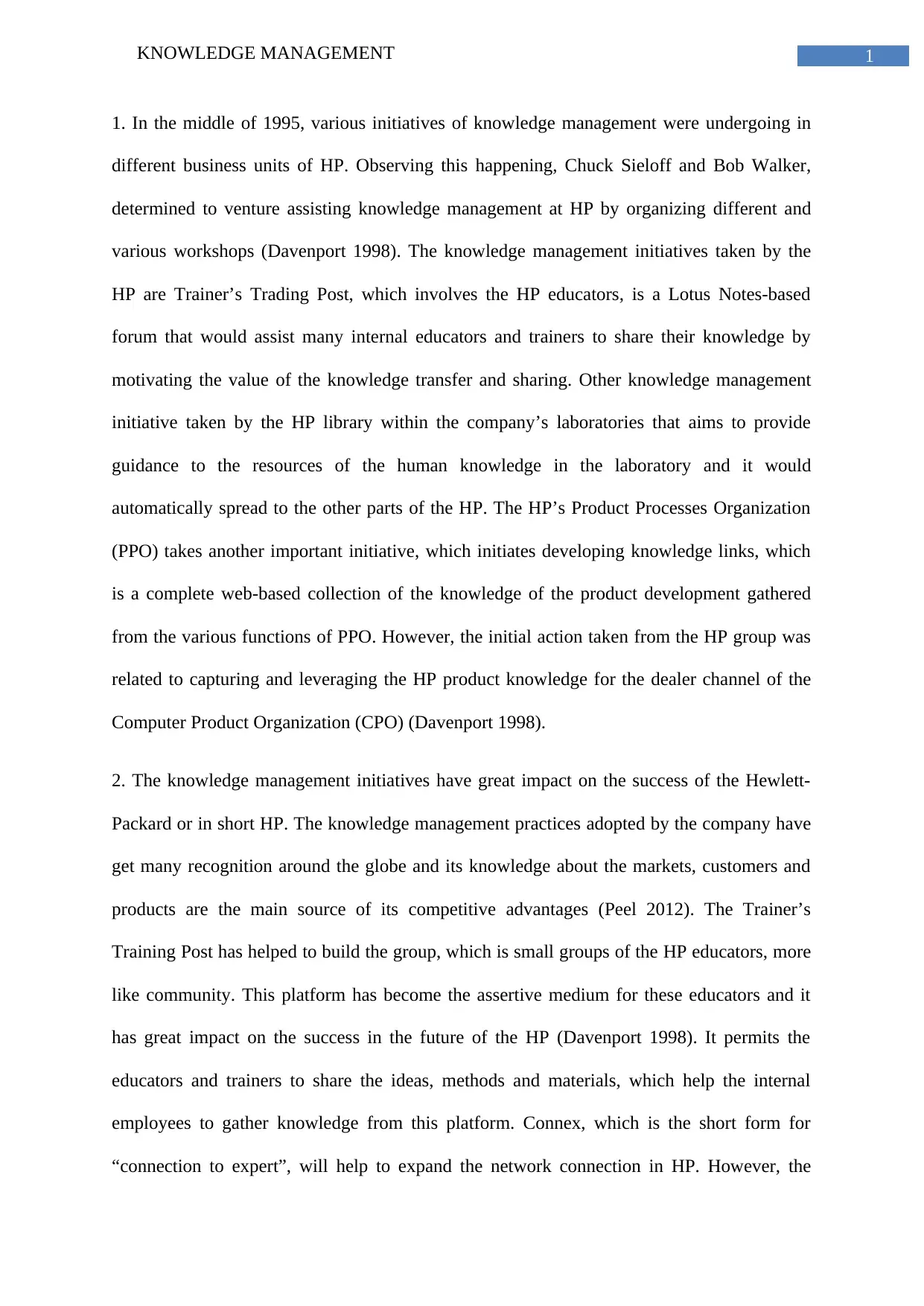
1KNOWLEDGE MANAGEMENT
1. In the middle of 1995, various initiatives of knowledge management were undergoing in
different business units of HP. Observing this happening, Chuck Sieloff and Bob Walker,
determined to venture assisting knowledge management at HP by organizing different and
various workshops (Davenport 1998). The knowledge management initiatives taken by the
HP are Trainer’s Trading Post, which involves the HP educators, is a Lotus Notes-based
forum that would assist many internal educators and trainers to share their knowledge by
motivating the value of the knowledge transfer and sharing. Other knowledge management
initiative taken by the HP library within the company’s laboratories that aims to provide
guidance to the resources of the human knowledge in the laboratory and it would
automatically spread to the other parts of the HP. The HP’s Product Processes Organization
(PPO) takes another important initiative, which initiates developing knowledge links, which
is a complete web-based collection of the knowledge of the product development gathered
from the various functions of PPO. However, the initial action taken from the HP group was
related to capturing and leveraging the HP product knowledge for the dealer channel of the
Computer Product Organization (CPO) (Davenport 1998).
2. The knowledge management initiatives have great impact on the success of the Hewlett-
Packard or in short HP. The knowledge management practices adopted by the company have
get many recognition around the globe and its knowledge about the markets, customers and
products are the main source of its competitive advantages (Peel 2012). The Trainer’s
Training Post has helped to build the group, which is small groups of the HP educators, more
like community. This platform has become the assertive medium for these educators and it
has great impact on the success in the future of the HP (Davenport 1998). It permits the
educators and trainers to share the ideas, methods and materials, which help the internal
employees to gather knowledge from this platform. Connex, which is the short form for
“connection to expert”, will help to expand the network connection in HP. However, the
1. In the middle of 1995, various initiatives of knowledge management were undergoing in
different business units of HP. Observing this happening, Chuck Sieloff and Bob Walker,
determined to venture assisting knowledge management at HP by organizing different and
various workshops (Davenport 1998). The knowledge management initiatives taken by the
HP are Trainer’s Trading Post, which involves the HP educators, is a Lotus Notes-based
forum that would assist many internal educators and trainers to share their knowledge by
motivating the value of the knowledge transfer and sharing. Other knowledge management
initiative taken by the HP library within the company’s laboratories that aims to provide
guidance to the resources of the human knowledge in the laboratory and it would
automatically spread to the other parts of the HP. The HP’s Product Processes Organization
(PPO) takes another important initiative, which initiates developing knowledge links, which
is a complete web-based collection of the knowledge of the product development gathered
from the various functions of PPO. However, the initial action taken from the HP group was
related to capturing and leveraging the HP product knowledge for the dealer channel of the
Computer Product Organization (CPO) (Davenport 1998).
2. The knowledge management initiatives have great impact on the success of the Hewlett-
Packard or in short HP. The knowledge management practices adopted by the company have
get many recognition around the globe and its knowledge about the markets, customers and
products are the main source of its competitive advantages (Peel 2012). The Trainer’s
Training Post has helped to build the group, which is small groups of the HP educators, more
like community. This platform has become the assertive medium for these educators and it
has great impact on the success in the future of the HP (Davenport 1998). It permits the
educators and trainers to share the ideas, methods and materials, which help the internal
employees to gather knowledge from this platform. Connex, which is the short form for
“connection to expert”, will help to expand the network connection in HP. However, the
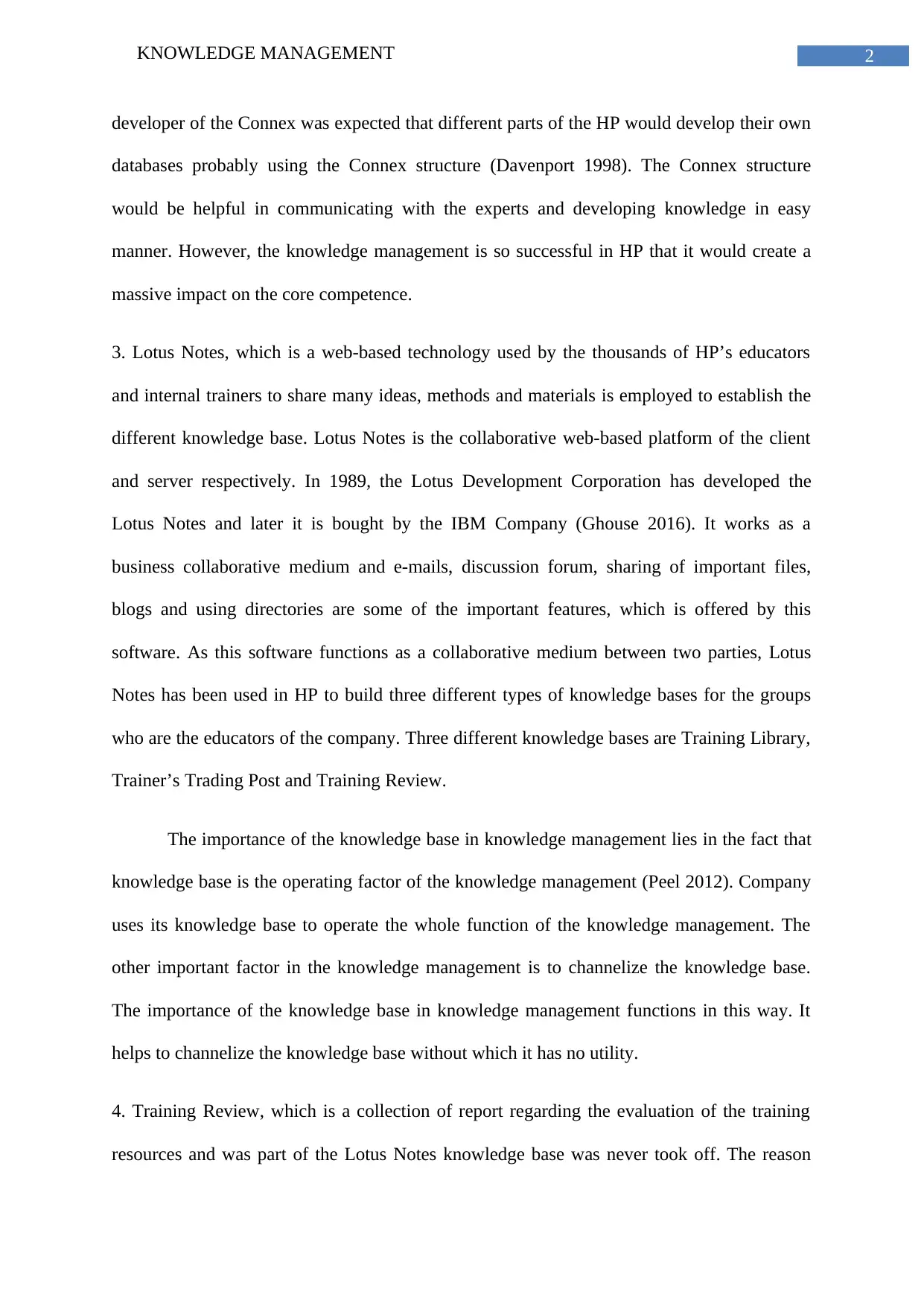
2KNOWLEDGE MANAGEMENT
developer of the Connex was expected that different parts of the HP would develop their own
databases probably using the Connex structure (Davenport 1998). The Connex structure
would be helpful in communicating with the experts and developing knowledge in easy
manner. However, the knowledge management is so successful in HP that it would create a
massive impact on the core competence.
3. Lotus Notes, which is a web-based technology used by the thousands of HP’s educators
and internal trainers to share many ideas, methods and materials is employed to establish the
different knowledge base. Lotus Notes is the collaborative web-based platform of the client
and server respectively. In 1989, the Lotus Development Corporation has developed the
Lotus Notes and later it is bought by the IBM Company (Ghouse 2016). It works as a
business collaborative medium and e-mails, discussion forum, sharing of important files,
blogs and using directories are some of the important features, which is offered by this
software. As this software functions as a collaborative medium between two parties, Lotus
Notes has been used in HP to build three different types of knowledge bases for the groups
who are the educators of the company. Three different knowledge bases are Training Library,
Trainer’s Trading Post and Training Review.
The importance of the knowledge base in knowledge management lies in the fact that
knowledge base is the operating factor of the knowledge management (Peel 2012). Company
uses its knowledge base to operate the whole function of the knowledge management. The
other important factor in the knowledge management is to channelize the knowledge base.
The importance of the knowledge base in knowledge management functions in this way. It
helps to channelize the knowledge base without which it has no utility.
4. Training Review, which is a collection of report regarding the evaluation of the training
resources and was part of the Lotus Notes knowledge base was never took off. The reason
developer of the Connex was expected that different parts of the HP would develop their own
databases probably using the Connex structure (Davenport 1998). The Connex structure
would be helpful in communicating with the experts and developing knowledge in easy
manner. However, the knowledge management is so successful in HP that it would create a
massive impact on the core competence.
3. Lotus Notes, which is a web-based technology used by the thousands of HP’s educators
and internal trainers to share many ideas, methods and materials is employed to establish the
different knowledge base. Lotus Notes is the collaborative web-based platform of the client
and server respectively. In 1989, the Lotus Development Corporation has developed the
Lotus Notes and later it is bought by the IBM Company (Ghouse 2016). It works as a
business collaborative medium and e-mails, discussion forum, sharing of important files,
blogs and using directories are some of the important features, which is offered by this
software. As this software functions as a collaborative medium between two parties, Lotus
Notes has been used in HP to build three different types of knowledge bases for the groups
who are the educators of the company. Three different knowledge bases are Training Library,
Trainer’s Trading Post and Training Review.
The importance of the knowledge base in knowledge management lies in the fact that
knowledge base is the operating factor of the knowledge management (Peel 2012). Company
uses its knowledge base to operate the whole function of the knowledge management. The
other important factor in the knowledge management is to channelize the knowledge base.
The importance of the knowledge base in knowledge management functions in this way. It
helps to channelize the knowledge base without which it has no utility.
4. Training Review, which is a collection of report regarding the evaluation of the training
resources and was part of the Lotus Notes knowledge base was never took off. The reason
⊘ This is a preview!⊘
Do you want full access?
Subscribe today to unlock all pages.

Trusted by 1+ million students worldwide
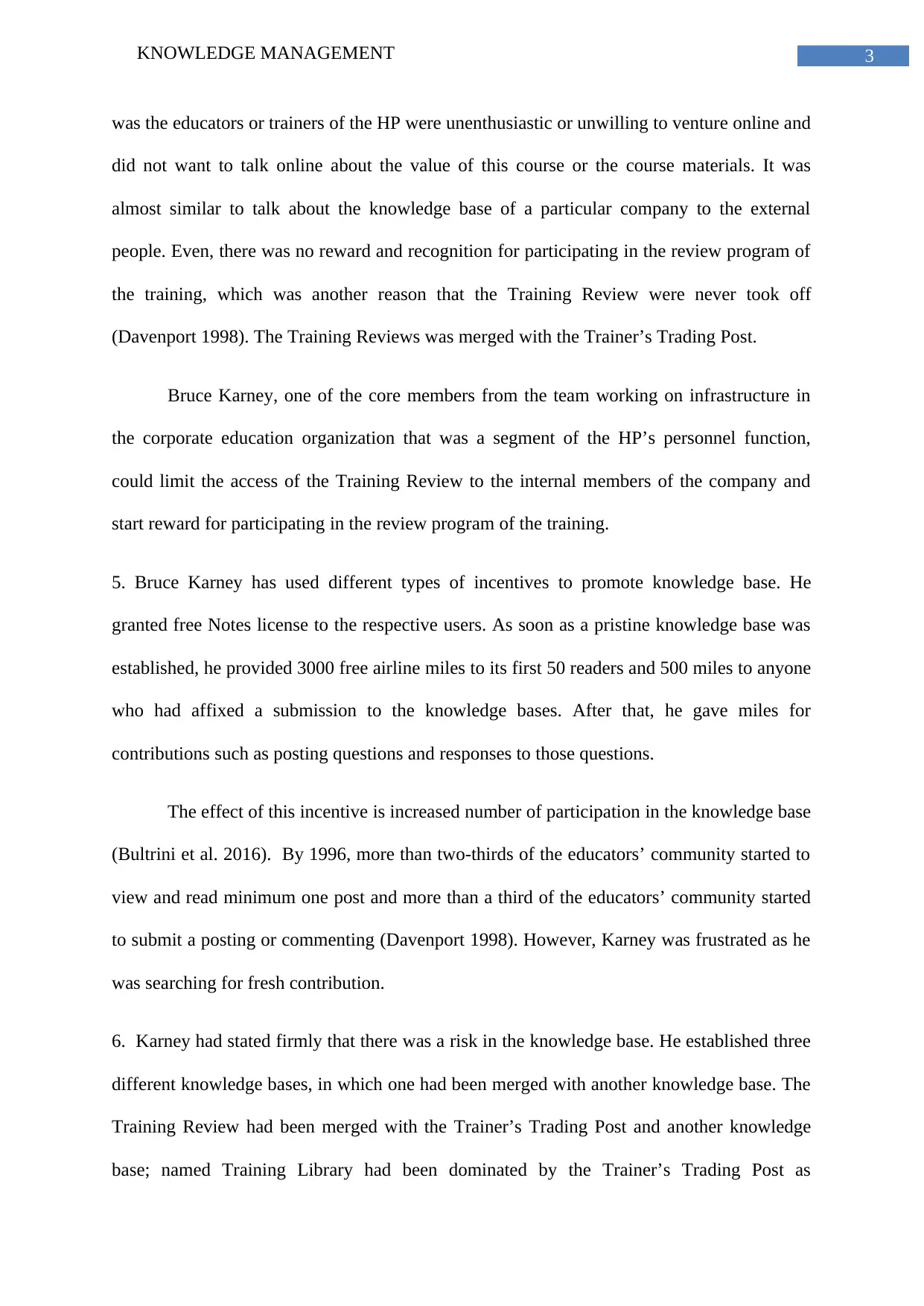
3KNOWLEDGE MANAGEMENT
was the educators or trainers of the HP were unenthusiastic or unwilling to venture online and
did not want to talk online about the value of this course or the course materials. It was
almost similar to talk about the knowledge base of a particular company to the external
people. Even, there was no reward and recognition for participating in the review program of
the training, which was another reason that the Training Review were never took off
(Davenport 1998). The Training Reviews was merged with the Trainer’s Trading Post.
Bruce Karney, one of the core members from the team working on infrastructure in
the corporate education organization that was a segment of the HP’s personnel function,
could limit the access of the Training Review to the internal members of the company and
start reward for participating in the review program of the training.
5. Bruce Karney has used different types of incentives to promote knowledge base. He
granted free Notes license to the respective users. As soon as a pristine knowledge base was
established, he provided 3000 free airline miles to its first 50 readers and 500 miles to anyone
who had affixed a submission to the knowledge bases. After that, he gave miles for
contributions such as posting questions and responses to those questions.
The effect of this incentive is increased number of participation in the knowledge base
(Bultrini et al. 2016). By 1996, more than two-thirds of the educators’ community started to
view and read minimum one post and more than a third of the educators’ community started
to submit a posting or commenting (Davenport 1998). However, Karney was frustrated as he
was searching for fresh contribution.
6. Karney had stated firmly that there was a risk in the knowledge base. He established three
different knowledge bases, in which one had been merged with another knowledge base. The
Training Review had been merged with the Trainer’s Trading Post and another knowledge
base; named Training Library had been dominated by the Trainer’s Trading Post as
was the educators or trainers of the HP were unenthusiastic or unwilling to venture online and
did not want to talk online about the value of this course or the course materials. It was
almost similar to talk about the knowledge base of a particular company to the external
people. Even, there was no reward and recognition for participating in the review program of
the training, which was another reason that the Training Review were never took off
(Davenport 1998). The Training Reviews was merged with the Trainer’s Trading Post.
Bruce Karney, one of the core members from the team working on infrastructure in
the corporate education organization that was a segment of the HP’s personnel function,
could limit the access of the Training Review to the internal members of the company and
start reward for participating in the review program of the training.
5. Bruce Karney has used different types of incentives to promote knowledge base. He
granted free Notes license to the respective users. As soon as a pristine knowledge base was
established, he provided 3000 free airline miles to its first 50 readers and 500 miles to anyone
who had affixed a submission to the knowledge bases. After that, he gave miles for
contributions such as posting questions and responses to those questions.
The effect of this incentive is increased number of participation in the knowledge base
(Bultrini et al. 2016). By 1996, more than two-thirds of the educators’ community started to
view and read minimum one post and more than a third of the educators’ community started
to submit a posting or commenting (Davenport 1998). However, Karney was frustrated as he
was searching for fresh contribution.
6. Karney had stated firmly that there was a risk in the knowledge base. He established three
different knowledge bases, in which one had been merged with another knowledge base. The
Training Review had been merged with the Trainer’s Trading Post and another knowledge
base; named Training Library had been dominated by the Trainer’s Trading Post as
Paraphrase This Document
Need a fresh take? Get an instant paraphrase of this document with our AI Paraphraser

4KNOWLEDGE MANAGEMENT
participants could attach materials on Training Library by submitting it to the Trainer’s
Trading Post (Davenport 1998). Kerney has adopted many unconventional tactics to gain
submissions in the knowledge base. He began to provide free Notes license and airline miles
to its users. By this process, Karney increased the amount of knowledge base as two-thirds of
the identified educators’ community started to read minimum one post and one thirds
submitted a posting and commenting. However, Kerney was frustrated and found out risk in
the knowledge base, which is the lack for the fresh contributions in spite of limitless attempt
with free e-mails and miles and voice mails.
Kerney proposed that the need of an evangelist to overcome the risk of the
knowledge. Actually, Kerney proposed for a converter who would take the responsibility to
convince the more participation to increase the knowledge base.
7. The knowledge management with the PPO customers was not successful, as the aim of
summarizing the knowledge management across PPO seemed to be overly ambitious. Thus,
the system for this was never built and it is not successful. The role of the PPO includes
corporate quality, product marketing, organizational change and procurement. The Product
Generation Information System (PGIS) operates each functions of the PPO. However, Bill
Kay, the director of the PPO, started to put PGIS at the centre of PPO as he revealed that
information management was to be a primary competence of PPO (Davenport 1998). The
knowledge management initiatives had been taken as a part of that competence. The
knowledge management group of PPO built some knowledge links that shared the data in
different employees. It was sort of “proof of concept’’ of the PPO group of the knowledge
management. Knowledge editors and reporters who accumulated this information from
various interviews and experts contributed the knowledge in the knowledge links of the PPO
knowledge management initiatives. However, the aim to summarize and abridge the
knowledge covering PPO demonstrated to be hugely ambitious and whole system was not
participants could attach materials on Training Library by submitting it to the Trainer’s
Trading Post (Davenport 1998). Kerney has adopted many unconventional tactics to gain
submissions in the knowledge base. He began to provide free Notes license and airline miles
to its users. By this process, Karney increased the amount of knowledge base as two-thirds of
the identified educators’ community started to read minimum one post and one thirds
submitted a posting and commenting. However, Kerney was frustrated and found out risk in
the knowledge base, which is the lack for the fresh contributions in spite of limitless attempt
with free e-mails and miles and voice mails.
Kerney proposed that the need of an evangelist to overcome the risk of the
knowledge. Actually, Kerney proposed for a converter who would take the responsibility to
convince the more participation to increase the knowledge base.
7. The knowledge management with the PPO customers was not successful, as the aim of
summarizing the knowledge management across PPO seemed to be overly ambitious. Thus,
the system for this was never built and it is not successful. The role of the PPO includes
corporate quality, product marketing, organizational change and procurement. The Product
Generation Information System (PGIS) operates each functions of the PPO. However, Bill
Kay, the director of the PPO, started to put PGIS at the centre of PPO as he revealed that
information management was to be a primary competence of PPO (Davenport 1998). The
knowledge management initiatives had been taken as a part of that competence. The
knowledge management group of PPO built some knowledge links that shared the data in
different employees. It was sort of “proof of concept’’ of the PPO group of the knowledge
management. Knowledge editors and reporters who accumulated this information from
various interviews and experts contributed the knowledge in the knowledge links of the PPO
knowledge management initiatives. However, the aim to summarize and abridge the
knowledge covering PPO demonstrated to be hugely ambitious and whole system was not
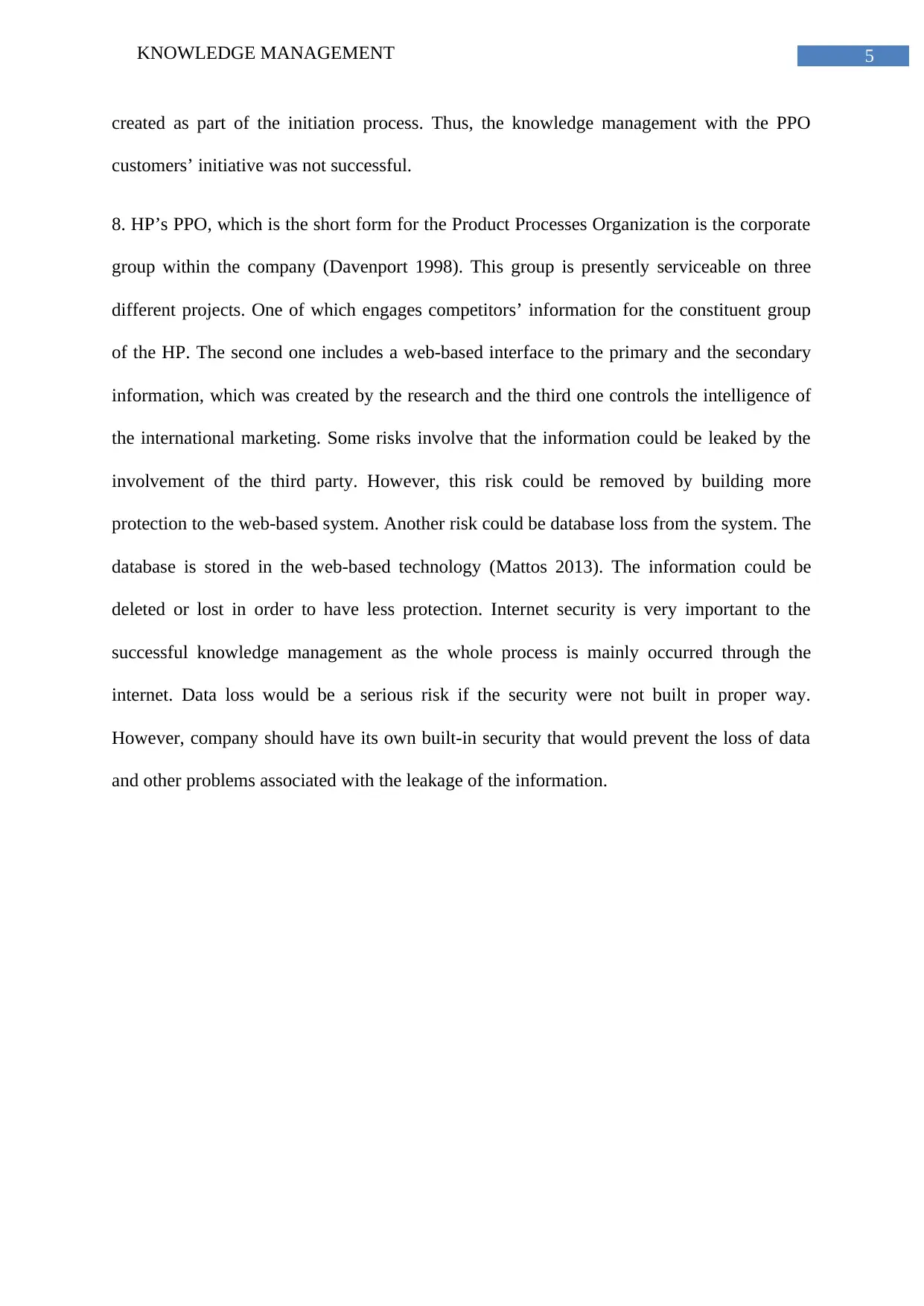
5KNOWLEDGE MANAGEMENT
created as part of the initiation process. Thus, the knowledge management with the PPO
customers’ initiative was not successful.
8. HP’s PPO, which is the short form for the Product Processes Organization is the corporate
group within the company (Davenport 1998). This group is presently serviceable on three
different projects. One of which engages competitors’ information for the constituent group
of the HP. The second one includes a web-based interface to the primary and the secondary
information, which was created by the research and the third one controls the intelligence of
the international marketing. Some risks involve that the information could be leaked by the
involvement of the third party. However, this risk could be removed by building more
protection to the web-based system. Another risk could be database loss from the system. The
database is stored in the web-based technology (Mattos 2013). The information could be
deleted or lost in order to have less protection. Internet security is very important to the
successful knowledge management as the whole process is mainly occurred through the
internet. Data loss would be a serious risk if the security were not built in proper way.
However, company should have its own built-in security that would prevent the loss of data
and other problems associated with the leakage of the information.
created as part of the initiation process. Thus, the knowledge management with the PPO
customers’ initiative was not successful.
8. HP’s PPO, which is the short form for the Product Processes Organization is the corporate
group within the company (Davenport 1998). This group is presently serviceable on three
different projects. One of which engages competitors’ information for the constituent group
of the HP. The second one includes a web-based interface to the primary and the secondary
information, which was created by the research and the third one controls the intelligence of
the international marketing. Some risks involve that the information could be leaked by the
involvement of the third party. However, this risk could be removed by building more
protection to the web-based system. Another risk could be database loss from the system. The
database is stored in the web-based technology (Mattos 2013). The information could be
deleted or lost in order to have less protection. Internet security is very important to the
successful knowledge management as the whole process is mainly occurred through the
internet. Data loss would be a serious risk if the security were not built in proper way.
However, company should have its own built-in security that would prevent the loss of data
and other problems associated with the leakage of the information.
⊘ This is a preview!⊘
Do you want full access?
Subscribe today to unlock all pages.

Trusted by 1+ million students worldwide
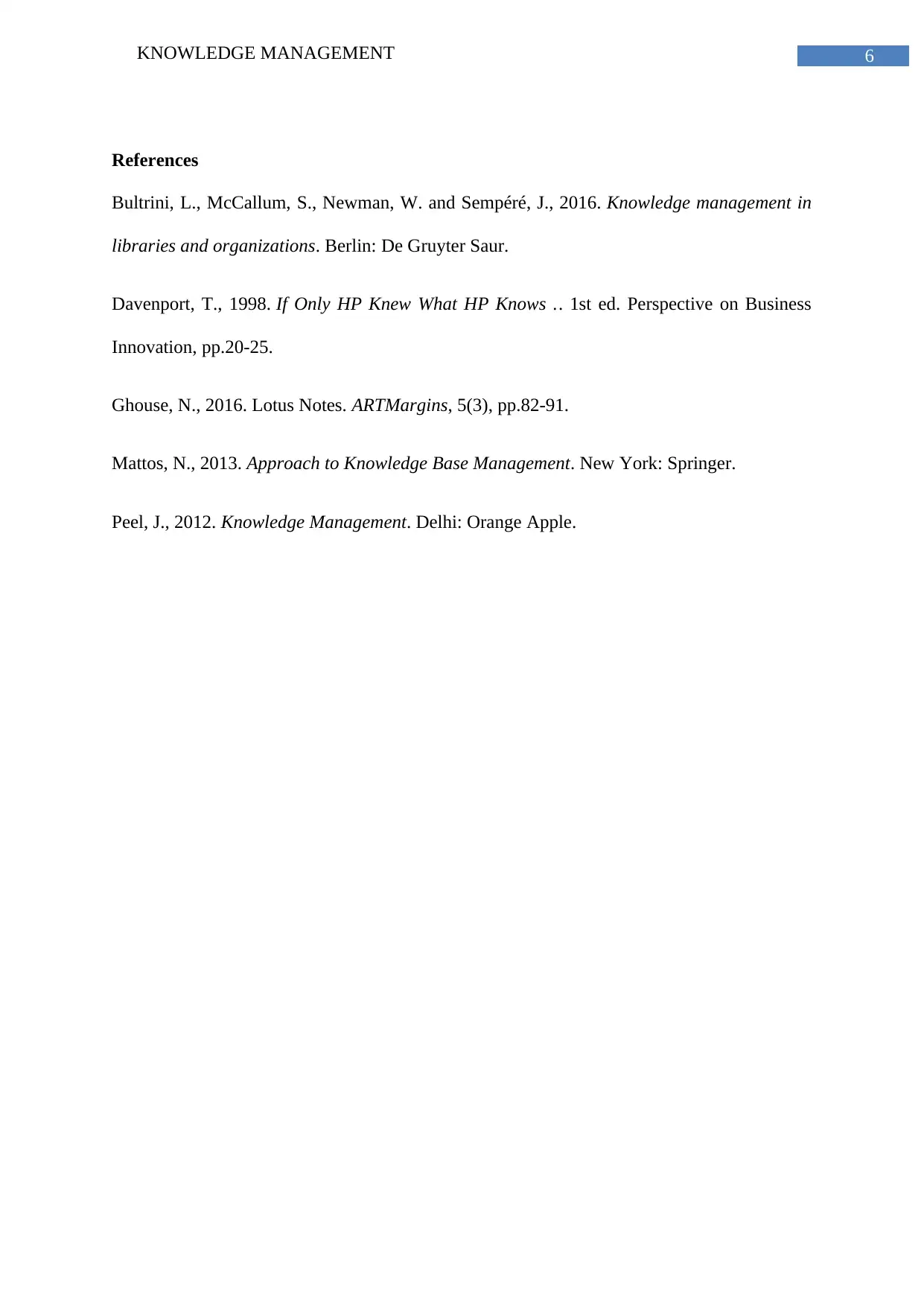
6KNOWLEDGE MANAGEMENT
References
Bultrini, L., McCallum, S., Newman, W. and Sempéré, J., 2016. Knowledge management in
libraries and organizations. Berlin: De Gruyter Saur.
Davenport, T., 1998. If Only HP Knew What HP Knows .. 1st ed. Perspective on Business
Innovation, pp.20-25.
Ghouse, N., 2016. Lotus Notes. ARTMargins, 5(3), pp.82-91.
Mattos, N., 2013. Approach to Knowledge Base Management. New York: Springer.
Peel, J., 2012. Knowledge Management. Delhi: Orange Apple.
References
Bultrini, L., McCallum, S., Newman, W. and Sempéré, J., 2016. Knowledge management in
libraries and organizations. Berlin: De Gruyter Saur.
Davenport, T., 1998. If Only HP Knew What HP Knows .. 1st ed. Perspective on Business
Innovation, pp.20-25.
Ghouse, N., 2016. Lotus Notes. ARTMargins, 5(3), pp.82-91.
Mattos, N., 2013. Approach to Knowledge Base Management. New York: Springer.
Peel, J., 2012. Knowledge Management. Delhi: Orange Apple.
1 out of 7
Related Documents
Your All-in-One AI-Powered Toolkit for Academic Success.
+13062052269
info@desklib.com
Available 24*7 on WhatsApp / Email
![[object Object]](/_next/static/media/star-bottom.7253800d.svg)
Unlock your academic potential
Copyright © 2020–2025 A2Z Services. All Rights Reserved. Developed and managed by ZUCOL.




